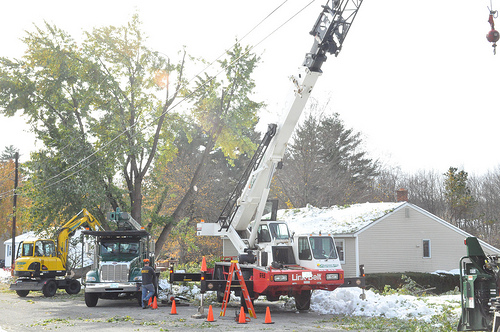Backup Internet connections in a storm are an important part of a disaster recovery plan as we recently witnessed in Snowtober in the northeast part of the U.S. Even if you have power, Internet service providers (ISPs) are often dependent on the power infrastructure elsewhere such that you may lose Internet access. What are the options to restore it to get e-mail and other critical services back?

As mentioned in Tropical Hurricane Irene - How To Restart Your Network Safely, there is a specific way to recover from an outage, but what do you do during the weather event? Here are some options to prepare for the eventuality of Internet service loss:
- Put a backup ISP in place. Depending on your budget this could be an alternate broadband provider (e.g. cable and fiber optic) or older technology (i.e. DSL or T1). You will need to configure your firewall to fail over appropriately.
- Deploy a router that supports cellular service. Even though your primary ISP may be down, cellular Internet service may still be available. The cradlepoint MBR Cellular Router is an inexpensive option that supports a wide variety of USB broadband devices. Not all services will function equally well. We found the Verizon Wireless Prepaid Novatel USB Modem to have superior service to the Virgin mobile Ovation MC760, for example.
- Enable emergency e-mail services. If you take advantage of spam filtering from such companies as AppRiver, they have a very nice email continuity service that allows you to access your e-mail through a Web browser if your on-premise Microsoft Exchange Server is unable to receive e-mail due to the lack of an Internet connection. This way, if you have a mobile device or some other means of getting on the Web, you can still function.
- Use always-on devices. With the advent of tablets such as the Apple iPad that are always connected to the Internet, we are no longer fully reliant on the traditional office network infrastructure. The more cloud capabilities that a business has, the easier it will be to continue operations in the case of an on-site outage.
The above options are by no means exhaustive and getting through an outage is non-trivial. There are many moving parts including firewalls, DNS services, SPAM filtering services, routers and other elements that must be configured in order for service to be restored on a temporary basis and then put back in place once the outage is over. This is just one of many examples of technology having a significant impact on the results of a business, making it critical to think proactively about how to manage information technology.
Are you prepared to deal with outages and disasters in your business?
Key takeaways:
- A little preparation for such eventualities as ISP outages can prevent a great deal of downtime in your business
- Backup ISPs and cellular service are low-cost options for short-term Internet continuity
- Emergency e-mail services allow for continuous communications when on-premise services are unable to function due to Internet outages
- Mobile devices such as tablets with always-on Internet service offer a great way to keep things going while infrastructure is restored
Photo credit: Jon DiPietro




